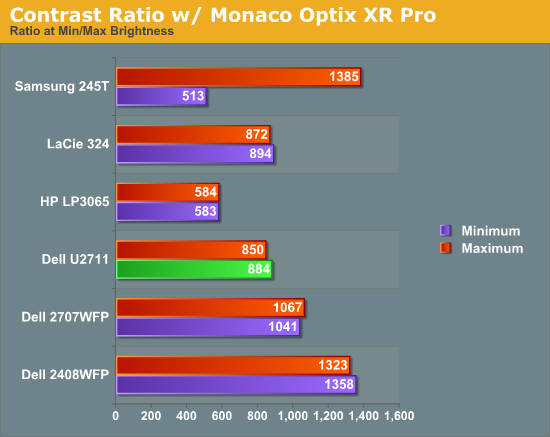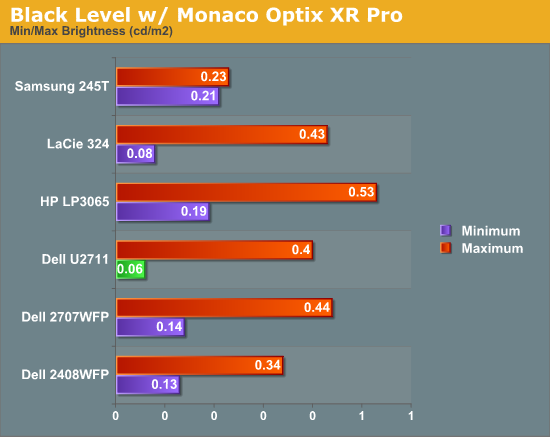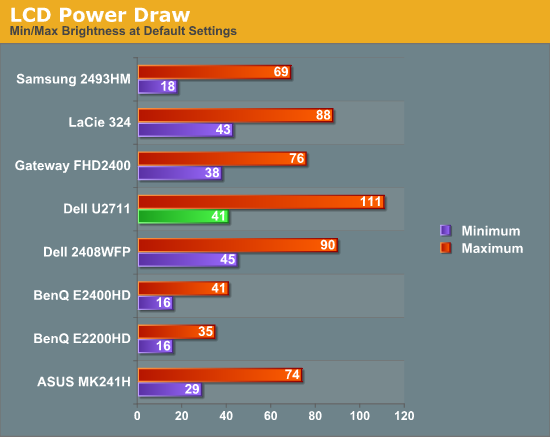Dell UltraSharp U2711: Quality has a Price
by Jarred Walton on January 22, 2010 2:00 AM EST- Posted in
- Displays
Brightness and Contrast
For the brightness, contrast, and color accuracy tests, we depend on a hardware colorimeter and software to help calibrate the displays. We use a Monaco Optix XR (DTP-94) colorimeter and Monaco Optix XR Pro software. Dell advertises a typical contrast ratio of 1000:1 and a maximum contrast (using dynamic backlight adjustment) of 80000:1. We're not interested in dynamic contrast, so we used the Adobe RGB setting for the results below. For those that are wondering, the reason we don't like dynamic contrast is that CCFL backlights take time to settle in and provide a consistent output, and if a display is constantly modifying the backlight level you won't get accurate colors.



Don't pay too much attention to the white/black graphs, as they are merely reference points for how the displays perform at certain settings. Like many other LCDs, the U2711 has a "normal" brightness level of around 260nits (the Adobe RBS setting defaults to 50% brightness and contrast), which is more than sufficient and is actually brighter than what most users prefer to use in an office environment. You can reach the advertised 350nits (give or take) if you max out brightness and contrast.
We're more interested in the contrast ratio, and here we find that the U2711 doesn't quite reach the advertised 1000:1 but instead comes closer to 850:1. We would have liked to see black levels a bit lower to improve the contrast, but really anywhere above 750:1 is difficult to see the difference, and 500:1 is sufficient for most users. At lower brightness settings, the contrast ratio improves to the point where our 100nits "print" result (~13% brightness) actually reached the advertised 1000:1 contrast ratio.
Power Requirements
Going along with the brightness levels, here are the power requirements we measured at the Windows desktop using the minimum brightness (53nits) setting along with 100nits (13%), 200nits (36%), and maximum brightness (340nits).

This is another area where we think the U2711 could be improved, but the cost might be too high right now. CCFL backlighting has been the norm since LCDs first came out, and it works but it's not the most power efficient way of lighting up an LCD. LEDs are the new and improved method, but while they can save power they also tend to deliver a lower color gamut. RGB LEDs address that shortcoming but they cost more and appear to use a similar amount of power compared to CCFL (and we've only seen them used in laptops so far). The U2711 draws a minimum of 41W, but a more realistic setting of 200nits will pull 72W. At maximum brightness the display settles down to 111W, but we measured a peak draw of 124W. (When we first cranked up brightness from 36% to 100%, brightness also reached 390nits before declining to 340nits.) We'd like to see LCDs that deliver all the color quality at half the power draw, but right now it's more a question of priorities: if you go green on power, your green colors may end up lacking. And to keep things in perspective, 72W at 200nits for a 27" LCD is still about half the power of your typical 21/22" CRT running at ~200nits!










153 Comments
View All Comments
JarredWalton - Friday, January 22, 2010 - link
Honestly, I'm sitting in from of my 3007WFP (not the HC version) and moving my head around and I just can't see anything. LOL.I'm looking at a white background and I can't see anything bothersome. I just did the same thing with a couple glossy laptops as well as the U2711 and I'm still not seeing anything sparkly. In fact, I just wandered around my lab and looked at six different LCDs (laptop and desktop, glossy and matte) and I'm still at a loss.
I might actually sort of see what you're referring to, but even then it just doesn't register as something distracting to my brain/eyes. My best guess is that either my eyes just aren't good enough to see it well (entirely possible), or my brain has adapted to where this effect doesn't affect me.
This is something I try to get across in my display reviews: you know what bothers you and I know what bothers me, and sometimes something that I totally don't see will irritate the hell out of others. If you can see/test a display in person, that's your best bet obviously. I figure if you're spending $1000 on a display, you'll want to do everything you can to make sure it's the right panel for you in advance of laying out the cash.
Caveat emptor, eh?
The0ne - Wednesday, January 27, 2010 - link
Not really. Most of the issues people are referring to and talking about are what I like to call "subjective preferences." People want things the way they like them to be will pay more attention to the features, defects, etc. For most users, they aren't even aware of most of this features/defects to even begin realizing and thus not seeing.Selecting a TV is no different. However, once you do start to pay attention to what others are saying then you will begin to notice as it becomes more apparent.
If you can't see and anomalies on your 30" I wouldn't worry about it or bother to do research. Doing so might just ruin your enjoyment of it. For those that care way way too much, they usually end up here...
AVS forums :o
MadMan007 - Friday, January 22, 2010 - link
You don't need to mvoe your head around to see it. I can get the same sort of thing only less severe on my LP2475W but only if I'm less than one foot away which is not normal use. With Dells I see it very easily from normal distance (2-3 feet.)If Dell still has a solid 100% back free shipping return policy on monitors there's little risk in trying them. All I know is when I tried a 2407WFP a few years back even without reference to another LCD I was like 'wtf is this?' and then found comments about the same thing from others. But obviously there are plenty of people who like Dell monitors so it's all personal preference. I was coming from a CRT and it was my first shot at an LCD if that matters but still it was immediately noticable to me. Maybe lighting plays a role too *shrug*
Given their return policy (if it's still the same) I don't see any problem recommending people try Dell monitors. The strong anti-glare is just something that for people who know they don't like it to the extent it's a deal breaker want to know ahead of time so they just won't bother.
icrf - Friday, January 22, 2010 - link
I've got a refurb 3007WFP-HC and it's definitely got the sparkliness going on. I only really noticed it when I first got the display and was scouring for dead pixels (got a couple, but they're hard to see, and the rest is immaculate, so I kept it). I guess I've gotten used to the sparkling, which is a much better term than grainy. It's never bothered me. I strongly prefer it to seeing a reflection of myself like a gloss finish.MadMan007 - Saturday, January 23, 2010 - link
I guess that's what sucks about being ugly :( ! lol :Ddasgib - Friday, January 22, 2010 - link
Thanks for your answer.Just to clarify: large white areas are shown as large, white areas, not as "large dusty/grained kind-of-white-but-not-really-white" areas? ;-)
Anyway, I'm really looking forward to the release of the devise. I haven't found any 24-inch that has no crappy colours or that frickin' grain :(
The LP2475w has _incredible_ colours and a very deep black - but it's extremely grainy - even in comparison to a really, really old and really cheap 22-inch TN panel.
MadMan007 - Friday, January 22, 2010 - link
If he says it looks the same as the 3007WFP then it likely has the typical Dell anti-glare coating. I just don't think he knows what it looks like or doesn't notice it any more. It just doesn't bother some people.hadphild - Friday, January 22, 2010 - link
Does this monitor cope with different Hz ranges?I am really looking for a monitor that can cope with all hz range up to 60hz. I work in a pro video environment and regularly need to use 50Hz outputs.
Patrick Wolf - Friday, January 22, 2010 - link
The only reason I'd see a gamer wanting this is if a resolution that high is really worth sacrificing size since you could just get a much larger (42"?) quality 1080P HDTV for roughly the same price.erple2 - Saturday, January 23, 2010 - link
If I'm doing work? Yes, I'd much, MUCH rather have more vertical pixels than a larger screen, no comparison at all. I'd pay significantly more for it too, than a "High Quality" TV with crummy resolution.I love the 1920x1200 15" screen on my laptop, thank you very much. I love the fact that I can see 4 windows at the same time on it. Using the company provided 14" screen with an (IMO) appalling 1280x800 resolution makes me feel so ... cramped.